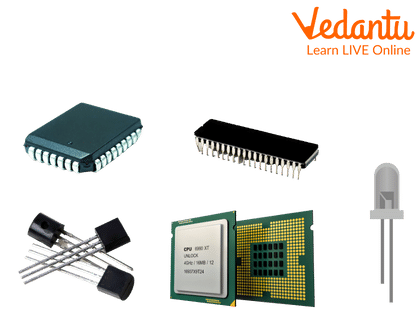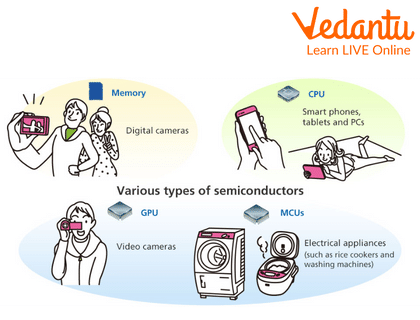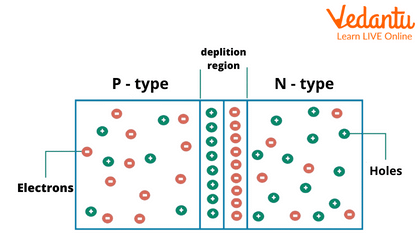




Introduction
A semiconductor is a material that is commonly used in the digital world. It serves as the foundation for the majority of electronic devices. It is used to make small devices such as diodes, transistors, and integrated chips (IC). These devices are found in computers, games, radios, mobile phones, robots, automatic factories, and various other applications. Semiconductors primarily drive today's technology. In this article, we will have an insight into the semiconductors and their uses, along with a few examples and solved questions. Let's start learning!!
What are Semiconductors?
Semiconductors are used for the materials whose conductivity lies in between a conductor and an insulator. Semi means half, and conductor refers to a material that allows current to flow.
An insulator prevents current flow and a conductor allows the flow of current.
Ultimately, A semiconductor is a material that contains both conductor and insulator properties. Electric current can easily pass through the copper conductor.
Further, rubber or wood is an insulator and will not allow an electric current to pass through. However, semiconductor materials such as silicon and germanium can be fabricated so that, under certain conditions, they can act as both a conductor and an insulator.

Semiconductor
What are Semiconductors Used For?
Semiconductors produce various electronic devices and components such as diodes, transistors, and integrated circuits. Because of their compactness, dependability, power efficiency, and low cost, such devices have widespread application.

Semiconductor in Everyday Life
Types of Semiconductors
Semiconductors are classified into two types: intrinsic and extrinsic. An intrinsic semiconductor is a semiconductor in its normal state. Intrinsic refers to the absence of any external material or impurity. On the other hand, an extrinsic semiconductor contains additional materials to increase its electrical strength.
Impurity is an external material, and the process of adding impurities is known as doping. During the doping process, two types of semiconductors are produced; one is known as N-type material, and the other as P-type material.

Types of Semiconductor
Semiconductors of the N-type:
An n-type semiconductor is an intrinsic semiconductor that has been doped with impurities such as phosphorus (P), arsenic (As), or antimony (Sb). For example, group IV silicon has four valence electrons, whereas Group V phosphorus has five.
The Semiconductor of the P-type:
P-type semiconductors are trivalent atom-doped like boron, indium, or gallium. Four silicon atoms surround the impurity atom. However, it can only fill three covalent bonds because it only has three valence electrons.
Semiconductors Today:
Semiconductors are widely used nowadays. Semiconductors are present in basically every electronic device. Without semiconductors, desktop computers, the Internet, tablet devices, and smartphones would not be possible.
Semiconductors can be made into exact switches with a small amount of voltage. The voltage not required by the semiconductor can be routed to other electrical components in the device.
Semiconductors can also be made very small, many fitting into a small circuit.
Electrical devices can now be made thin and lightweight without sacrificing processing power because they can be made so small. Intel Corporation, Samsung Electronics, TSMC, Qualcomm, and Micron Technology are among the leading semiconductor companies.
Solved Questions
1. An increase in temperature at room temperature increases the conductivity of_______.
(a) a semiconductor
(b) a conductor
(c) a superconductor
(d) an insulator
Answer: (a) a semiconductor
2. In__________, the energy band gap is greatest.
(a) copper
(b) an insulator
(c) germanium
(d) a superconductor
Answer: (b) an insulator
3. At room temperature, a substance's valence band and conduction band overlap. The substance could be______
(a) a p-type semiconductor
(b) a conductor
(c) an insulator
(d) an n-type semiconductor
Answer: (b) a conductor
Summary:
Classification of crystalline solids with conductivity intermediate between a conductor and an insulator. Semiconductors are used to make electronic devices like diodes, transistors, and integrated circuits. Extrinsic semiconductors contain impurities that increase conductivity significantly. These materials can be chemically treated to allow the transmission and control of an electric current.
FAQs on Uses of Semiconductors
1. Is silicon a type of semiconductor?
Yes, most semiconductor chips and transistors are made of silicon, the preferred raw material due to its stable structure.
2. What is the purpose of semiconductors?
Semiconductors are commonly found in electronic devices such as chips, diodes, transistors, and integrated circuits. In addition, semiconductors are used in everything that is computerized or uses radio waves.
3. What are the elements used in semiconductors?
Semiconductors can be pure elements such as silicon, carbon, and germanium, or conductors doped (with a small amount of impurity) with phosphorus, arsenic, boron, or gallium (N-type doping) (P-type doping).
4. What is an N-type semiconductor used ?
An N-type semiconductor material is used in electronics, and it can be formed by adding an impurity to a semiconductor such as Si or Ge. Arsenic, phosphorus, bismuth, antimony, and other donor impurities are used in the semiconductor.
5. What are the types of semiconductors?
Semiconductors are classified into two types: intrinsic and extrinsic. An intrinsic semiconductor is a semiconductor in its normal state. An extrinsic semiconductor contains additional materials to increase its electrical strength.









